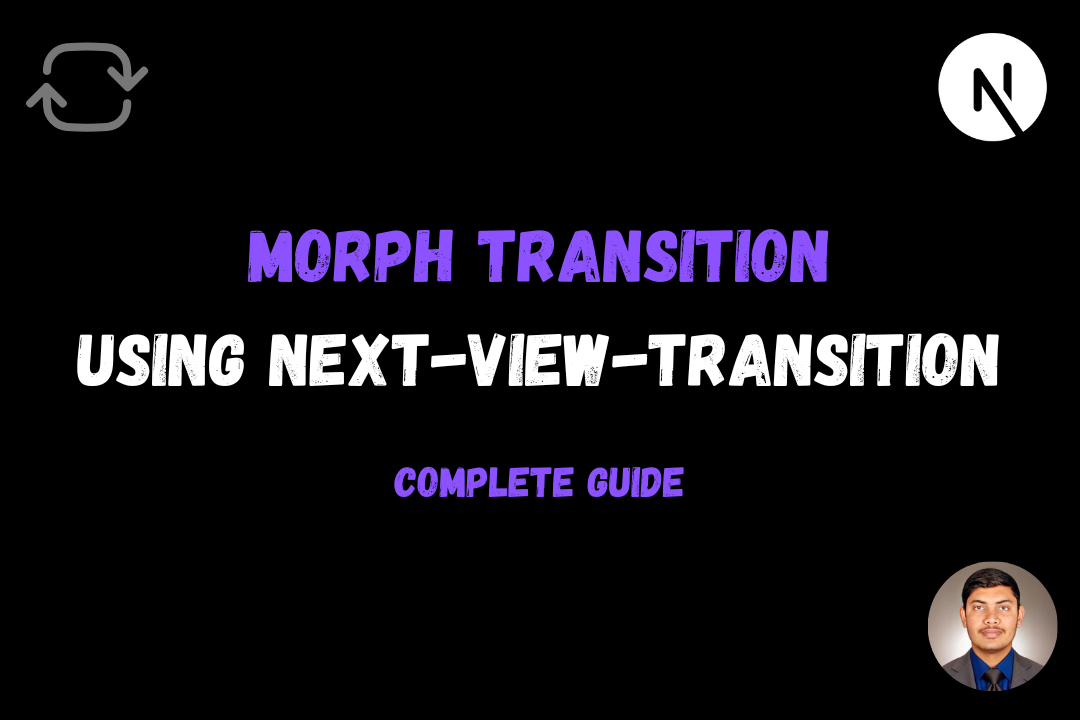Beautiful Morph Transition using next-view-transition Next.js
By Rohit Yadav on 04-06-2025
5 min read

Creating beautiful morph transitions in your Next.js applications can significantly enhance user experience. The next-view-transition library provides a powerful way to implement these transitions seamlessly. In this guide, we'll explore how to set up and use this library to create stunning morph transitions.
What is next-view-transition?
next-view-transition is a library designed to simplify the implementation of view transitions in Next.js applications. It allows developers to create smooth and visually appealing transitions between different views or components, enhancing the overall user experience.
It works on View Transitions API, which is a new web standard that allows developers to create smooth transitions between different states of a web application. It provides a way to animate changes in the DOM, such as when navigating between pages or updating content dynamically by taking a snapshot of the current view and animating to the new view.
Setting Up next-view-transition
To get started with next-view-transition, follow these steps:
1. Install the Library
npm install next-view-transition
2. Configure Next.js
Ensure your Next.js application is set up to use the next-view-transition library. You may need to update your next.config.js file to include any necessary configurations.
module.exports = {
experimental: {
viewTransitions: true, // Enable view transitions
},
};
3. Wrap Your Application with ViewTransitions Provider
To use the next-view-transition library, you need to wrap your application with the ViewTransitions. This is typically done in your root layout.jsx or layout.tsx file.
import './globals.css';
import { ViewTransitions } from 'next-view-transition';
export default function RootLayout({ children }) {
return (
<html lang="en">
<body>
<ViewTransitions>
{children}
</ViewTransitions>
</body>
</html>
);
}
Now, we'll create two pages to demonstrate the morph transition. The first page will display some text, and when we navigate to the second page, a simple text morphing effect will occur..
4. Create the First Page
Create a new file /app/home/page.jsx and add the following code:
import { Link } from 'next-view-transition';
export default function HomePage() {
return (
<div className="container">
<h1 style={{viewTransitionName: 'welcome-text'}}>Welcome, Rohit</h1>
<p>This is the first page of our morph transition example.</p>
<Link href="/about" className="transition-link">
Go to About Page
</Link>
</div>
);
}
5. Create the Second Page
Create another file /app/about/page.jsx and add the following code:
import { Link } from 'next-view-transition';
export default function AboutPage() {
return (
<div className="container">
<h1 style={{viewTransitionName: 'welcome-text'}}>Welcome, Rohit</h1>
<p>This is the second page of our morph transition example.</p>
<Link href="/home" className="transition-link">
Go to Home Page
</Link>
</div>
);
}
Note: The viewTransitionName attribute is used to identify the element for the transition. This name must be unique for each element, and both elements should have the same tag. For example, if one element is an <h1>, the other must also be an <h1>.
6. Run Your Application
Now, you can run your Next.js application to see the morph transition in action:
npm run dev
Open your browser and navigate to http://localhost:3000/home. Click on the "Go to About Page" link, and you should see a smooth morph transition effect as the text changes from "Welcome, Rohit" on the home page to the same text on the about page.
Conclusion
Using the next-view-transition library, you can easily create beautiful morph transitions in your Next.js applications. This enhances the user experience by providing smooth and visually appealing transitions between different views or components. Experiment with different styles and animations to make your application even more engaging!
Feel free to explore the library's documentation for more advanced features and customization options. Happy coding!
Hire me for your next project - Let's chat!
Drop me a message and let's bring your idea to life.
Drop your email below and I will get back to you soon.
Made with Love by Rohit Yadav
Portfolio inspired by Manu Arora